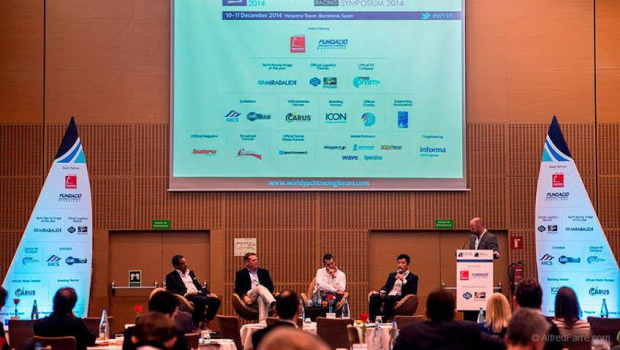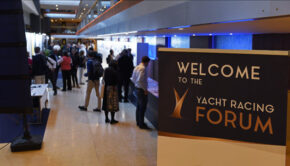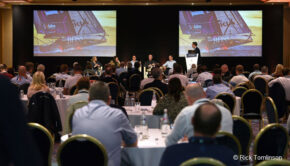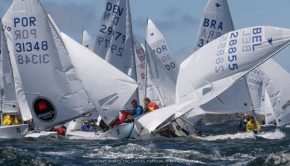World Yacht Racing Forum completes seventh edition
Published on December 11th, 2014
Barcelona, Spain (December 11, 2014) – Some 200 delegates and 50 speakers spanning seventeen nations participated in the seventh edition of the World Yacht Racing Forum and Yacht Racing Design and Technology Symposium in Barcelona over the past two days (Dec 10-11).
Whilst the World Yacht Racing Forum focused on the commercial aspects of the sport, the Yacht Racing Design and Technology Symposium showcased the industry’s latest technological developments and innovations. Some sponsors involved in high end yacht racing also attended the event, and shared their experience with the audience.
Founder of Open Sports Management and – amongst others – Deputy Chairman of the London Olympic Games organizing Committee, Sir Keith Mills highlighted the fact that the sport of sailing is too fragmented, difficult to understand by a wide audience and lacks international strategy. “We have a big job to do “, he insisted. ” ISAF needs to be much stronger and look at all the sides of the sport instead of just the Olympic Games. What yacht racing needs is a strong base, superstars and heroes, and to be more accessible. It also needs to focus on three or four major pillars, like tennis or car racing do. ”
Discussing what sailing can learn from other sports, Mike Gascoyne, founder of MGI and Formula 1 expert, said that “sailing today looks like Formula 1 thirty years ago. When there is an issue, people often don’t tell the other teams or sailors what’s happened. They hide and lie. I know: that’s what we’ve been doing in F1 during 25 years. The only way to overcome this is to have a strong governing body.”
Class Secretary for the TP 52 and Mini Maxi Class, Rob Weiland insisted: “We need to go past those owners, designers and sailors who believe they know everything. Only a strong governing structure can achieve this.”
Debates focusing on sailing’s development in emerging markets, sponsorship, digital media or classes also kept the audience’ attention, alongside current events such as the Volvo Ocean Race or the Extreme Sailing Series. Team Vestas’ future in the Volvo Ocean Race was also a hot topic, although the key stakeholders involved in the conference – builders Multiplast, Decision and Green Marine, designer Pat Shaugnessy (Farr Yacht Design) or VOR Class project manager James Dadd weren’t ready to answer precise questions from the audience.
Involved in the VOR as a sponsor, Cem Bozkurt, CEO of Alvimedica, took a more commercial stance in his presentation, explaining that a successful campaign needs to be based around a long term strategy. ” Our plan is to be active over ten years at least”, he said. “We started our program by developing internal sailing courses for our staff during three years, in order to develop a sailing culture in our company. We now compete in the Volvo Ocean Race, and will be back for the next edition. We will also organise other events in the mean time, including sailing on Farr 40’s.”
Many interesting and highly stimulating presentations took place over the two days conference, impossible to summarize in a few lines. The general consensus was positive, with sailing’s key actors insisting on the importance of the Forum for the industry. “This edition has been very successful, with good delegate numbers and many of the world’s most influential players”, said James Gradwell, World Yacht Racing Forum Conference Producer. “We really need to thank our sponsors and the Barcelona World Race, who have been extremely helpful.”
With help from Seahorse USA Editor Dobbs Davis, the one-day format of the Yacht Racing Design & Technology Symposium focused on the application of design and technology solutions to the sport. The Symposium is an important adjunct to the Forum in generating valuable ideas on what is technically practical and achievable within the bounds of format and cost for sailing’s various classes and events.
Topics this year included technical lessons learned from the Volvo Ocean Race, including the recent grounding of Vestas; cross-over technologies in composite engineering and fabrication from marine and non-marine industries; new developments in the field of basic research; design ideas on the upcoming AC 62 multihulls for the 35th America’s Cup; and the current developments and trends in the growth of high-performance monohull designs, ranging from TP 52’s to Maxi 72’s to 100-footers and Supermaxi’s.
Some salient points made from the leaders in these fields were that the VO 65’s – born during the World Yacht Racing Forum 2012 – are performing well to expectation in delivering the right balance of performance, reliability and excitement whilst within incredibly tight one-design parameters: VO 65 class manager James Dadd and Geoff Stock from Green Marine explained the total difference in weight among all 7 entries is only 29 kg, and that all teams now share their ideas in a cooperative environment not possible in other rule formats. In composite technology, YRDTS attendees learned from Yann Penfornis of Multiplast, Bertrand Cardis of Decision and Mike Gascoyne of MGI that cross-overs from non-marine applications such as F1 and aerospace is actually not always one-way towards sailing, but is often oriented in the other direction, where the knowledge learned from fabricating complex high-tech structures in yachts can influence and improve the engineering in a diverse array of non-sailing products.
Basic research in the science of sailing used to be funded by the America’s Cup and trickle down to the rest of the sport, but now new sources of support are needed. The Sailing Yacht Research Foundation (SYRF) is one of those sources, and its Technical Director Myles Cornwell described the projects that SYRF currently supports, including a new online research library that will catalogue published papers and data gathered in aero and hydrodynamic research and it designed as an accessible resource for academics, researchers, designers, sailors and others interested in the science of sailing. Dr. Patrick Bot from the French Naval Academy discussed their full-scale testing program used to help validate modeling and RANS/FEM tools used in the race yacht design.
As a member of the design team at Ben Ainslie Racing, Dirk Kramers would not reveal too many details about their thoughts on AC 62 design, but admitted that the recent venue choice would have an influence on design, but that other decisions will have to await further announcements on format, timing, etc. Given AC developments in stored energy, Kramers reckons there will be more acceptance of this technology in conventional boats in the future. As a veteran designer in several America’s Cup cycles, Manolo Ruiz Del Elvira provided an excellent overview of the AC 62 class rules and the questions faced by design teams, and suggested that performance prediction and assessment tools will be very important given the short timelines of the event.
In high-performance monohulls, designer Juan Kouyoumdjian joined the YRDTS by Skype from Newport, USA on the occasion of the launch of the newest Rambler, a 27-meter yacht designed for first-to-finish performance in a variety of the world’s ocean races, and that this boat has increased performance by over 15% from the last generation of fully-crewed first-to-finish designs. TP 52 Class Manager Rob Weiland revealed the ways he has carefully managed the balance between the desire to innovate to produce speed and cost controls to keep the existing fleet competitive over a reasonable lifespan to maintain stability in class size. International Maxi Class General Secretary Andrew MacIrvine discussed the features of the various classes within the IMA, and that the recently re-named Maxi 72 Class will likely grow in attraction to the growing number of Superyacht owners who want to race on faster, more competitive platforms. MacIrvine also explained that some ocean race organizers have recognized the popularity in these boats exceeding 30.5 m and are now allowing them to compete.
The seventh edition of the World Yacht Racing Forum closed its doors following two days of presentations, constructive debates and networking sessions.
Details of the conference programme and speakers are available on the event’s website: www.worldyachtracingforum.com
Source: Bernard Schopfer, MaxComm Communication
About the World Yacht Racing Forum:
Now in its 7th year, the World Yacht Racing Forum is the leading yacht racing industry conference, and is the only occasion in the year where key players from yacht racing event organizers, teams, sponsors, agencies and sailors gather together and help shape the future of the yacht racing industry, discussing topical debates.
The WYRF brings together over 300 decision makers in one place at one time to do business and meet future clients.
Running parallel to the Forum, the Yacht Racing Design & Technology Symposium focuses on the latest developments issued form the America’s Cup, foils and flying boats, rigid sails and new materials. The Symposium brings an important technical counterpoint to the commercial discussions that occur in the Forum.









 We’ll keep your information safe.
We’ll keep your information safe.